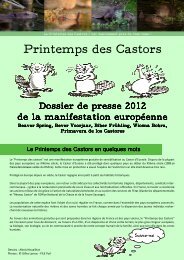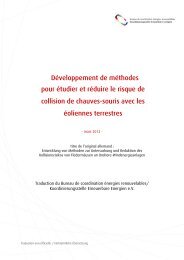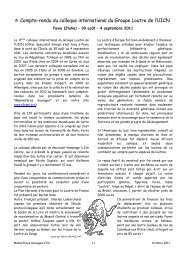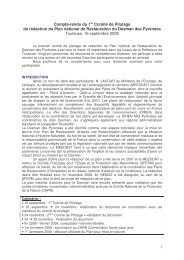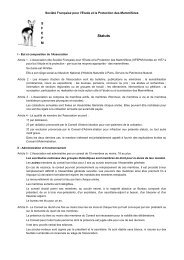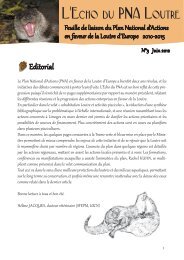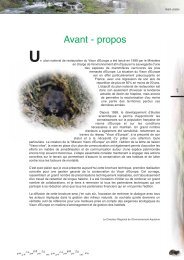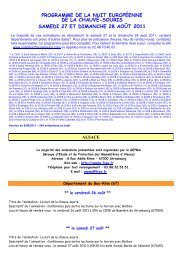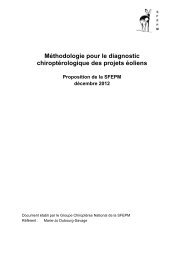Accueillir des chauves-souris dans le bâti et les jardins - Société ...
Accueillir des chauves-souris dans le bâti et les jardins - Société ...
Accueillir des chauves-souris dans le bâti et les jardins - Société ...
Create successful ePaper yourself
Turn your PDF publications into a flip-book with our unique Google optimized e-Paper software.
Vespertilionidés : c<strong>et</strong>te grande famil<strong>le</strong> inclut la majorité <strong>des</strong> espèces françaises, y compris <strong>le</strong>s<br />
plus communes d’entre el<strong>le</strong>s. Leur distinction n’étant pas toujours aisée, nous ne détail<strong>le</strong>rons<br />
que <strong>le</strong> profil de chaque groupe ou <strong>des</strong> espèces <strong>le</strong>s plus emblématiques :<br />
1a. La chauve-<strong>souris</strong> a <strong>des</strong> oreil<strong>le</strong>s démesurées, qui se touchent sur <strong>le</strong><br />
front groupe <strong>des</strong> Oreillards<br />
1b. La chauve-<strong>souris</strong> n’a pas d’oreil<strong>le</strong>s démesurées (el<strong>le</strong>s peuvent tout de<br />
même être assez gran<strong>des</strong>) mais el<strong>le</strong>s se touchent sur <strong>le</strong> front<br />
La chauve-<strong>souris</strong> est très sombre, avec <strong>des</strong> oreil<strong>le</strong>s presque carrées<br />
qui se touchent sur son front Barbastel<strong>le</strong> d’Europe (photo page 17)<br />
Oreillard<br />
1c. La chauve-<strong>souris</strong> n’a pas <strong>le</strong>s caractères indiqués ci-<strong>des</strong>sus<br />
voir 2<br />
2a. L’animal ne présente pas de différence de coloration marquée entre<br />
<strong>le</strong> ventre <strong>et</strong> <strong>le</strong> dos voir 3<br />
2b. L’animal présente une différence de coloration marquée entre <strong>le</strong><br />
ventre <strong>et</strong> <strong>le</strong> dos<br />
groupe <strong>des</strong> Myotis = murins (plusieurs espèces, tail<strong>le</strong> variab<strong>le</strong>)<br />
Barbastel<strong>le</strong><br />
2c. S’il est impossib<strong>le</strong> de distinguer ce critère du fait de la position de<br />
l’animal<br />
Vespertilionidé non identifiab<strong>le</strong><br />
3a. La chauve-<strong>souris</strong> est de la tail<strong>le</strong> d’une pellicu<strong>le</strong> photo ou plus p<strong>et</strong>ite<br />
Pipistrel<strong>le</strong>s (4 espèces, communes)<br />
Murin à moustaches<br />
(murin de p<strong>et</strong>ite tail<strong>le</strong>)<br />
3b. La chauve-<strong>souris</strong> est plus grande qu’une pellicu<strong>le</strong> photo<br />
groupe <strong>des</strong> Sérotines & Noctu<strong>le</strong>s<br />
Grand murin<br />
(murin de grande tail<strong>le</strong>)<br />
Noctu<strong>le</strong> commune (plutôt arborico<strong>le</strong>)<br />
Sérotines communes (anthropophi<strong>le</strong>s)<br />
Pipistrel<strong>le</strong>s<br />
<strong>Accueillir</strong> <strong>des</strong> <strong>chauves</strong>-<strong>souris</strong> <strong>dans</strong> <strong>le</strong> bâti <strong>et</strong> <strong>le</strong>s <strong>jardins</strong> – p. 21




